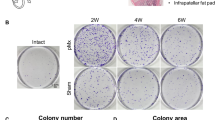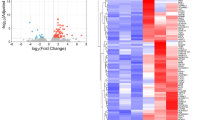Abstract
Synovial chondromatosis (SC) is a disorder of the synovium characterized by the formation of osteochondral nodules within the synovium. This study aimed to identify the abnormally differentiated progenitor cells and possible pathogenic signaling pathways. Loose bodies and synovium were obtained from patients with SC during knee arthroplasty. Single-cell RNA sequencing was used to identify cell subsets and their gene signatures in SC synovium. Cells derived from osteoarthritis (OA) synovium were used as controls. Multi-differentiation and colony-forming assays were used to identify progenitor cells. The roles of transcription factors and signaling pathways were investigated through computational analysis and experimental verification. We identified an increased proportion of CD34+ sublining fibroblasts in SC synovium. CD34+CD31− cells and CD34−CD31− cells were sorted from SC synovium. Compared with CD34− cells, CD34+ cells had larger alkaline phosphatase (ALP)-stained area and calcified area after osteogenic induction. In addition, CD34+ cells exhibited a stronger tube formation ability than CD34− cells. Our bioinformatic analysis suggested the expression of TWIST1, a negative regulator of osteogenesis, in CD34− sublining fibroblasts and was regulated by the TGF-β signaling pathway. The experiment showed that CD34+ cells acquired the TWIST1 expression during culture and the combination of TGF-β1 and harmine, an inhibitor of Twist1, could further stimulate the osteogenesis of CD34+ cells. Overall, CD34+ synovial fibroblasts in SC synovium have multiple differentiation potentials, especially osteogenic differentiation potential, and might be responsible for the pathogenesis of SC.






Similar content being viewed by others
Data availability
The data that support the findings of this study have been deposited into the CNGB Sequence Archive (CNSA) of China National GeneBank DataBase (CNGBdb) with accession number CSE0000088.
References
Agaram NP, Zhang L, Dickson BC et al (2020) A molecular study of synovial chondromatosis. Genes Chromosom Cancer 59:144–151. https://doi.org/10.1002/gcc.22812
Aibar S, González-Blas CB, Moerman T et al (2017) SCENIC: single-cell regulatory network inference and clustering. Nat Methods 14:1083–1086. https://doi.org/10.1038/nmeth.4463
Amary F, Perez-Casanova L, Ye H et al (2019) Synovial chondromatosis and soft tissue chondroma: extraosseous cartilaginous tumor defined by FN1 gene rearrangement. Mod Pathol 32:1762–1771. https://doi.org/10.1038/s41379-019-0315-8
Buddingh EP, Krallman P, Neff JR et al (2003) Chromosome 6 abnormalities are recurrent in synovial chondromatosis. Cancer Genet Cytogenet 140:18–22. https://doi.org/10.1016/s0165-4608(02)00636-2
Chen S, Zhou Y, Chen Y, Gu J (2018) fastp: an ultra-fast all-in-one FASTQ preprocessor. Bioinform 34:i884–i890. https://doi.org/10.1093/bioinformatics/bty560
Cheng J, Zhang J, Wu Z, Sun X (2021) Inferring microenvironmental regulation of gene expression from single-cell RNA sequencing data using scMLnet with an application to COVID-19. Brief Bioinform 22:988–1005
Coughlan B, Feliz A, Ishida T et al (1995) p53 Expression and DNA ploidy of cartilage lesions. Hum Pathol 26:620–624. https://doi.org/10.1016/0046-8177(95)90166-3
Croft AP, Campos J, Jansen K et al (2019) Distinct fibroblast subsets drive inflammation and damage in arthritis. Nature 570:246–251. https://doi.org/10.1038/s41586-019-1263-7
Dobin A, Davis CA, Schlesinger F et al (2013) STAR: ultrafast universal RNA-seq aligner. Bioinform 29:15–21. https://doi.org/10.1093/bioinformatics/bts635
Dominici M, Le Blanc K, Mueller I et al (2006) Minimal criteria for defining multipotent mesenchymal stromal cells. The International Society for Cellular Therapy position statement. Cytotherapy 8:315–317. https://doi.org/10.1080/14653240600855905
Fan J, Varshney RR, Ren L et al (2009) Synovium-derived mesenchymal stem cells: a new cell source for musculoskeletal regeneration. Tissue Eng Part B Rev 15:75–86. https://doi.org/10.1089/ten.teb.2008.0586
Harvanová D, Tóthová T, Sarišský M et al (2011) Isolation and characterization of synovial mesenchymal stem cells. Folia Biol (praha) 57:119–124
Hopyan S, Nadesan P, Yu C et al (2005) Dysregulation of hedgehog signalling predisposes to synovial chondromatosis. J Pathol 206:143–150. https://doi.org/10.1002/path.1761
Isenmann S, Arthur A, Zannettino ACW et al (2009) TWIST family of basic helix-loop-helix transcription factors mediate human mesenchymal stem cell growth and commitment. Stem Cells 27:2457–2468. https://doi.org/10.1002/stem.181
Jin S, Guerrero-Juarez CF, Zhang L et al (2021) Inference and analysis of cell-cell communication using Cell Chat. Nat Commun 12:1088
Li Y, Cai H, Fang W et al (2014) Fibroblast growth factor 2 involved in the pathogenesis of synovial chondromatosis of temporomandibular joint. J Oral Pathol Med 43:388–394. https://doi.org/10.1111/jop.12146
Li Y, El Mozen LA, Cai H et al (2015) Transforming growth factor beta 3 involved in the pathogenesis of synovial chondromatosis of temporomandibular joint. Sci Rep 5:8843. https://doi.org/10.1038/srep08843
Li F, Tang Y, Song B et al (2019) Nomenclature clarification: synovial fibroblasts and synovial mesenchymal stem cells. Stem Cell Res Ther 10:1–7
Milgram JW (1977) Synovial osteochondromatosis: a histopathological study of thirty cases. J Bone Joint Surg Am 59:792–801
Miraoui H, Severe N, Vaudin P et al (2010) Molecular silencing of Twist1 enhances osteogenic differentiation of murine mesenchymal stem cells: implication of FGFR2 signaling. J Cell Biochem 110:1147–1154
Mizuno M, Katano H, Mabuchi Y et al (2018) Specific markers and properties of synovial mesenchymal stem cells in the surface, stromal, and perivascular regions. Stem Cell Res Ther 9:123. https://doi.org/10.1186/s13287-018-0870-9
Mochizuki T, Muneta T, Sakaguchi Y et al (2006) Higher chondrogenic potential of fibrous synovium- and adipose synovium-derived cells compared with subcutaneous fat-derived cells: distinguishing properties of mesenchymal stem cells in humans. Arthritis Rheum 54:843–853. https://doi.org/10.1002/art.21651
Ning H, Lin G, Lue TF, Lin C-S (2006) Neuron-like differentiation of adipose tissue-derived stromal cells and vascular smooth muscle cells. Differentiation 74:510–518. https://doi.org/10.1111/j.1432-0436.2006.00081.x
Noda S, Hosoya T, Komiya Y et al (2022) CD34+ THY1+ synovial fibroblast subset in arthritic joints has high osteoblastic and chondrogenic potentials in vitro. Arthritis Res Ther 24:45
Quarto N, Senarath-Yapa K, Renda A, Longaker MT (2015) TWIST1 silencing enhances in vitro and in vivo osteogenic differentiation of human adipose-derived stem cells by triggering activation of BMP-ERK/FGF signaling and TAZ upregulation. Stem Cells 33:833–847. https://doi.org/10.1002/stem.1907
Robinson D, Hasharoni A, Evron Z et al (2000) Synovial chondromatosis: the possible role of FGF 9 and FGF receptor 3 in its pathology. Int J Exp Pathol 81:183–189. https://doi.org/10.1046/j.1365-2613.2000.00154.x
Rookmaaker MB, Verhaar MC, Loomans CJM et al (2005) CD34+ cells home, proliferate, and participate in capillary formation, and in combination with CD34− cells enhance tube formation in a 3-dimensional matrix. Arterioscler Thromb Vasc Biol 25:1843–1850. https://doi.org/10.1161/01.ATV.0000177808.92494.14
Smith T, Heger A, Sudbery I (2017) UMI-tools: modeling sequencing errors in Unique Molecular Identifiers to improve quantification accuracy. Genome Res 27:491–499. https://doi.org/10.1101/gr.209601.116
Stephenson W, Donlin LT, Butler A et al (2018) Single-cell RNA-seq of rheumatoid arthritis synovial tissue using low-cost microfluidic instrumentation. Nat Commun 9:791. https://doi.org/10.1038/s41467-017-02659-x
Sun H, Zhao X, Zhang C et al (2018) MiR-455-3p inhibits the degenerate process of chondrogenic differentiation through modification of DNA methylation. Cell Death Dis 9:537
Sviland L, Malcolm A, j. (1995) Synovial chondromatosis presenting as painless soft tissue mass—a report of 19 cases. Histopathology 27:275–279. https://doi.org/10.1111/j.1365-2559.1995.tb00221.x
Tasev D, Konijnenberg LSF, Amado-Azevedo J et al (2016) CD34 expression modulates tube-forming capacity and barrier properties of peripheral blood-derived endothelial colony-forming cells (ECFCs). Angiogenesis 19:325–338. https://doi.org/10.1007/s10456-016-9506-9
Unger RE, Krump-Konvalinkova V, Peters K, Kirkpatrick CJ (2002) In vitro expression of the endothelial phenotype: comparative study of primary isolated cells and cell lines, including the novel cell line HPMEC-ST1.6R. Microvasc Res 64:384–397. https://doi.org/10.1006/mvre.2002.2434
Wake M, Hamada Y, Kumagai K et al (2013) Up-regulation of interleukin-6 and vascular endothelial growth factor-A in the synovial fluid of temporomandibular joints affected by synovial chondromatosis. Br J Oral Maxillofac Surg 51:164–169. https://doi.org/10.1016/j.bjoms.2012.03.004
Wittkop B, Davies AM, Mangham DC (2002) Primary synovial chondromatosis and synovial chondrosarcoma: a pictorial review. Eur Radiol 12:2112–2119. https://doi.org/10.1007/s00330-002-1318-1
Yochum ZA, Cades J, Mazzacurati L et al (2017) A first-in-class TWIST1 inhibitor with activity in oncogene-driven lung cancer. Mol Cancer Res 15:1764–1776. https://doi.org/10.1158/1541-7786.MCR-17-0298
Yu G, Wang L-G, Han Y, He Q-Y (2012) clusterProfiler: an R package for comparing biological themes among gene clusters. OMICS: J Integr Biol 16:284–287. https://doi.org/10.1089/omi.2011.0118
Zudaire E, Gambardella L, Kurcz C, Vermeren S (2011) A computational tool for quantitative analysis of vascular networks. PLoS ONE 6:e27385
Funding
This study was funded by the National Key R&D Program of China (Grant No. 2021YFA1102600), National Natural Science Foundation of China (Grant No. 82002293, 82272443), Guangdong Basic and Applied Basic Research Foundation (Grant No. 2021A1515010294, 2021A1515010693, 2022A1515010256), and Science and Technology Planning Project of Guangzhou City, China (Grant No. 202201020495, 202201020481).
Author information
Authors and Affiliations
Contributions
Xiaoyu Li, Hao Sun and Deng Li contributed equally to this work. Xiaoyu Li and Hao Sun contributed to the conception of the study. Deng Li and Zhiqing Cai acquired the data. Xiaoyu Li and Hao Sun contributed significantly to analysis and manuscript preparation. Deng Li validated the results. Jie Xu and Ruofan Ma revised the work critically for important intellectual content. All authors read and approved the final manuscript.
Corresponding authors
Ethics declarations
Ethics approval
The acquisition of human synovium was approved by the Ethics Committee of Sun-Yat Sen Memorial Hospital (SYSEC-KY-KS-2020-233).
Informed consent
Written informed consent was obtained from the individuals for the publication of any potentially identifiable images or data included in this article.
Conflict of interest
The authors declare no competing interests.
Additional information
Publisher's Note
Springer Nature remains neutral with regard to jurisdictional claims in published maps and institutional affiliations.
Supplementary Information
Below is the link to the electronic supplementary material.
Rights and permissions
Springer Nature or its licensor (e.g. a society or other partner) holds exclusive rights to this article under a publishing agreement with the author(s) or other rightsholder(s); author self-archiving of the accepted manuscript version of this article is solely governed by the terms of such publishing agreement and applicable law.
About this article
Cite this article
Li, X., Sun, H., Li, D. et al. CD34+ synovial fibroblasts exhibit high osteogenic potential in synovial chondromatosis. Cell Tissue Res (2024). https://doi.org/10.1007/s00441-024-03892-9
Received:
Accepted:
Published:
DOI: https://doi.org/10.1007/s00441-024-03892-9




